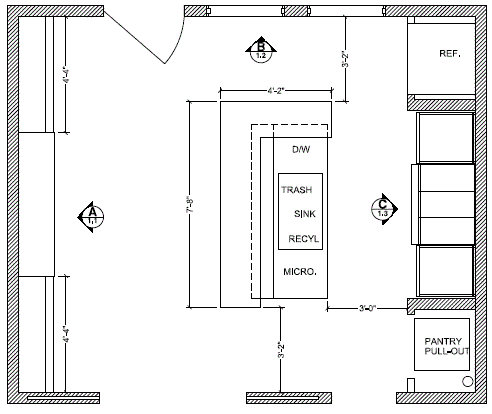Good design is probably the most effective green building technique there is, more than how much you salvage, what chemicals are not used or what technology you put into the house.
Good design is what makes a house green or not green.
With this green builders perspectivein mind, reading the classic book The Design of Everyday Things by Donald Norman was very interesting.
His book is not about green building. It is about the mechanics, psychology and sociology of design. He gives lots of examples of both good and bad design as well as explores the science behind design.
It was very informative for me as a green builder and it really confirmed the absolute necessity of good design for any green building to work correctly.
The importance of design in green building is obvious to any builder but the details often get overlooked.
The classic example is the “green kitchen”. Here is a floor plan of a kitchen we designed:
It has custom FSC, formaldahide free cabinets, custom salvaged wood counters, zero voc oils on the wood and floor, salvaged old plank flooring and super high efficient appliances.
These are all great green elements. They drastically reduce the ecological impact of building the kitchen.
However, what happens during the 20 years that the kitchen is used? This is where design really kicks in. I would say the single most important design element in the above floor plan is the dedicated recycling space.
If we had not included that then the homeowner would be forced to have a container in the corner somewhere. It would be ugly and inconvenient. There is a chance they don’t get the container. The impetus is on the user to be proactive about recycling and we all know that people are much less likely to do something if it takes extra effort. The easiest thing is to just throw that tin can in with the rest of the garbage.
However if the recycling compartment is built into the kitchen design then the homeowner, being human and looking for the easiest solution in their busy day, will do the easiest thing. And the easiest thing is to put their recycling out of sight into the handy little recycling compartment.
Over the twenty years of using the kitchen this is a massive amount of recycled material! All because of a simple design element.
What is missing from this kitchen design? A composting compartment! That was a massive oversight on our part. Big mistake.
Green design, like all good design, is seamless and makes the user’s life easier, in this case it makes their life easier to be green. Dedicated composting and recycling areas in the kitchen are classic examples.
Another example is good lighting controls and layout. Good green lighting design uses the least amount of lights to illuminate the maximum amount of space in the home. Gone are the lit walls that look very dramatic but consume lots of electricity and don’t light up the room.
Instead you use artful placement to create a beautiful space that is energy efficient. You put almost no lighting in passage areas like hallways and stairs. You don’t need much light to walk those areas. You focus the light on task areas like a kitchen counter or reading chair. But the rest of the room does not need to be lit up like a stadium. It is just uneeded wasted energy.

